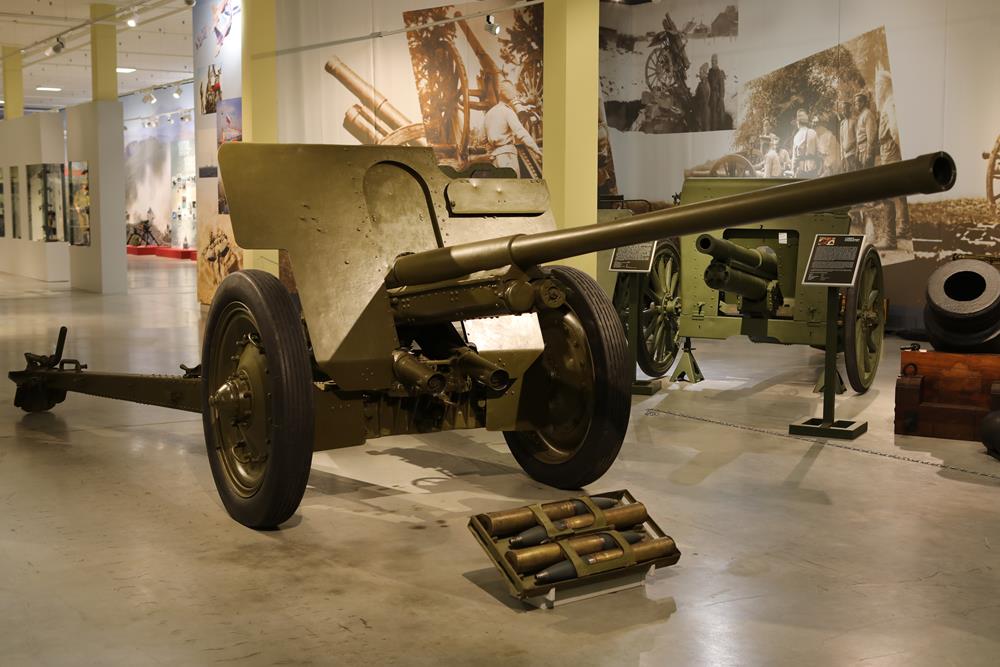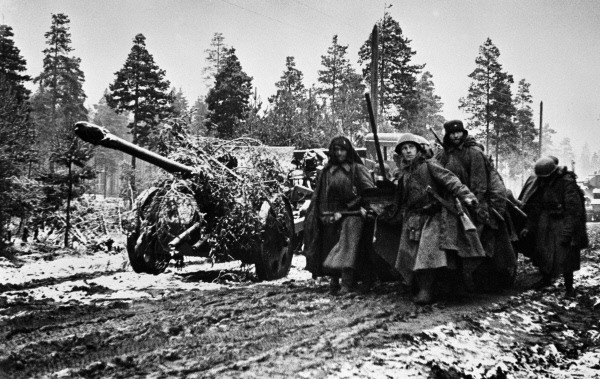The Book of Armaments:
Soviet 76.2mm Guns, Part Two
by Mike Bennighof, Ph.D.
May 2021
 The Soviet Union’s Second Five Year Plan, launched in 1933, would continue the First Five Year Plan’s emphasis on heavy industry. But now the steel mills and rolling plants completed during the previous phase, and the new production added to them, would feed new and refurbished factories turning that steel and other materials into finished goods. Railroads, urban mass transit and water craft would all be emphasized, and also heavy equipment for the Red Army of Workers and Peasants – tanks and artillery. The Soviet Union’s Second Five Year Plan, launched in 1933, would continue the First Five Year Plan’s emphasis on heavy industry. But now the steel mills and rolling plants completed during the previous phase, and the new production added to them, would feed new and refurbished factories turning that steel and other materials into finished goods. Railroads, urban mass transit and water craft would all be emphasized, and also heavy equipment for the Red Army of Workers and Peasants – tanks and artillery.
For weapons and other military goods, the Plan emphasized not only reliance on domestic sources of production, but domestic designs as well. Previous artillery pieces had either been license-built copies of foreign weapons, or had been built to designs purchased from foreign firms. The Soviet Union would continue to keep abreast of overseas developments, and purchase examples when necessary – for example, the destroyer leader Tashkent, built in an Italian yard – but as much as possible, the armed forces would be equipped with Soviet-made armaments.
To replace the aged Model 1902 76.2mm divisional gun, as well as the modernized Model 1902/30, Marshal Mikhail Tukhachevsky, the 1st Deputy Commissar for People’s Defense, advocated for a recoilless gun proposed by the crackpot weapons designer Leonid Kurchevsky. Kurchevsky had designed his cannon while imprisoned for embezzling state funds (and using them to build a personal helicopter). The weapon used a standard barrel from a Model 1902 field gun, which made it just as heavy as the older field piece, and performed poorly. Soon after his patron was purged and executed, Kurchevsky was sentenced to death for “creating unpromising weapons systems” and met a firing squad. Soviet weapons designers shied away from recoilless guns for a generation afterwards.

Finnish troops captured this Kurchevsky recoilless gun during the Winter War.
Tukhachevsky had also urged the creation of a “universal cannon” that could serve equally well as an anti-aircraft gun, anti-tank gun, and field gun. Other generals pushed for replacement of the divisional guns with 122mm howitzers, which weighed almost exactly the same as they did not require barrels as heavy as those of a direct-fire weapon and could lob explosive shells with three times the weight of a 76.2mm cannon’s high-explosive rounds. The German and American armies would follow this path, equipping their light artillery battalions with 105mm howitzers, but Tukhachevsky won the day with his argument that the universal cannon’s greater mission flexibility more than made up for its smaller explosive charge.
Four different design bureaus completed prototypes of the universal cannon. None of them proved very effective as anti-aircraft guns; the existing 76.2mm Model 1931 anti-aircraft gun, modeled on a German-made Rheinmetall 75mm piece, remained significantly better at high-angle fire. But the Red Army was already committed to a universal cannon for its light artillery battalions, and the choice fell on the best of the four, the F22 designed by V.G. Grabin.

This F22 76.2mm field gun resides in the Polikovo Military Museum.
The F22, soon re-named the Model 1936, had a number of good qualities: a high muzzle velocity that made it a fine anti-tank gun, good range and a stable carriage. But the effort to include anti-aircraft capabilities hampered its effectiveness. It lacked all-round traverse, could not be moved quickly and lacked the muzzle velocity to fling its rounds to even medium altitude. No instances were reported of it ever being used against aircraft during the Great Patriotic War, and it appears that the Red Army did not bother to issue the anti-aircraft sights prepared for the universal gun.
It was a large and heavy weapon, making it difficult to move and emplace; the crew could not shift it by themselves. The compressor fluid easily overheated, and the gun sight and vertical guidance were on different sides of the barrel, meaning that a single gunner could not aim the weapon – two men were required, who had to shout their adjustments to each other. This made it difficult to hit a moving target in the anti-tank role. “The gun is universal,” one of the test crews reported, “but it does not satisfy any purpose.”
While the cannon had good range in theory, in practice its crews found fairly wide dispersal of long-range shots. It had good accuracy at shorter ranges. Despite its shortcomings, the Model 1936 went into mass production in 1936 at three different plants. It proved difficult to construct, exposing the weaknesses of the new Soviet industrial base’s rapidly-recruited and only partially skilled labor force. Production halted in 1939, with 2,932 of them having been produced (some sources put the number slightly higher or slightly lower).
The Red Army assigned the new gun to its light artillery battalions, with a rifle division fielding between 16 and 24 of them as its table of organization (shtat) continually shifting in the years just before the Great Patriotic War. Red Army practice did not mix different models in the same division; all batteries were re-equipped simultaneously.

An F22 76.2mm field gun on the Leningrad Front, November 1941.
About 2,300 of them were present in the western military districts when the Axis launched their sneak attack. The disastrous battles of 1941 and 1942 left over 1,200 of the Model 1936 in German hands; the Finns took an additional 86 cannon and the Romanians captured at least that many (the Armata Romana took 693 76.2mm cannon during the first two years of the war, but the sources don’t specify their models).
Despite the weapon’s shortcomings in the eyes of the Red Army, the Germans eagerly pressed it into service. They issued new ammunition which increased its muzzle velocity, replaced the sights, fitted a new breach and added a muzzle brake to ease the cannon’s excessive recoil. In all 560 guns were issued as towed anti-tank guns (7.62cm Pak (r)) and another 894 placed on self-propelled mounts as the Marder II and Marder III tank destroyers; the numbers apparently also include converted examples of the Model 1939 field cannon.
The Germans (and their Axis allies) found the weapon much more useful than its original owners had; it was one of the few weapons they had in early 1942 that could defeat the armor of the T34 tank. It continued in Axis service until the end of the war, with the Finnish Army retaining theirs until the 1990’s. Some of the modified guns were in turn re-captured by the Red Army, which issued them to its own anti-tank regiments. Though never officially withdrawn from service in the Red Army, it became less common as the war went on as the excellent ZiS-3 model became the standard light field gun.
You can order The Book of Armaments: Eastern Front Artillery right here.
Sign up for our newsletter right here. Your info will never be sold or transferred; we'll just use it to update you on new games and new offers.
Mike Bennighof is president of Avalanche Press and holds a doctorate in history from Emory University. A Fulbright Scholar and NASA Journalist in Space finalist, he has published way too many books, games and articles on historical subjects.
He lives in Birmingham, Alabama with his wife, three children and his dog Leopold. Leopold is streamlined and modern.
Want to keep Daily Content free of third-party ads? You can send us some love (and cash) through this link right here.
|
